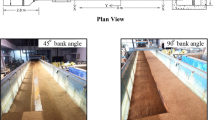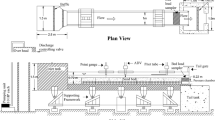Abstract
A comprehensive understanding of velocity distribution is the fundamental information hydraulic engineers need to estimate an alluvial channel's discharge and stage characteristics. This study examines the Tsallis entropy approach for estimating streamwise velocity patterns in open channels. Entropy, which quantifies system uncertainty, has been applied in hydraulic research to account for variables such as shear strength, silt content, and flow velocities. However, its applicability to non-uniform channel sections remains unexplored. In the current work, the velocities estimation under various experimental conditions was calculated using the Tsallis entropy approach, wherein the random variable employed for constructing the velocity estimations was the time-averaged normalised velocity. This study considered two experimental conditions: (1) channels with attached spurs under seepage and non-seepage conditions and (2) channels with a 31-degree bank slope with and without an upstream pit. The velocity pattern obtained closely corresponds to the experimental data, exhibiting significant accuracy. However, it should be noted that the accuracy of the velocity pattern is slightly diminished in the region near the spur field when the \(y/D\) value is below \(0.3.\) The difference can be caused by factors such as the area's non-uniform cross-section, sediment interaction along the bed, and secondary currents, which ultimately affect the velocity profile.









Similar content being viewed by others
Data availability
The datasets used and analysed during the current study are available from the corresponding author upon reasonable request.
References
Ahamed N, Kundu S (2022) Application of the fractional entropy for one-dimensional velocity distribution with dip-phenomenon in open-channel turbulent flows. Stoch Environ Res Risk Assess 36(5):1289–1312
Arora S, Patel HK, Lade AD, Kumar B (2023a) Turbulence structure and bank erosion process in a dredged channel. River Res Appl 39(4):613–628
Arora S, Lade AD, Kumar B (2023b) Higher-order turbulence statistics and multiscale characterisation of morphodynamics in a riverbank section with an upstream mining pit. Phys Fluids 35:066607
Barman J, Roy M, Kumar B (2023) Velocity estimation in compound channels with different bank slopes using Renyi and Tsallis entropy. Stoch Environ Res Risk Assess 1–16
Bousmar D, Zech Y (2004) Velocity distribution in non-prismatic compound channels. In: Proceedings of the institution of civil engineers-water management (Vol. 157, No. 2, pp 99–108). Thomas Telford Ltd
Carollo FG, Ferro V, Termini D (2002) Flow velocity measurements in vegetated channels. J Hydraul Eng 128(7):664–673
Chen X, Chiew YM (2004) Velocity distribution of turbulent open-channel flow with bed suction. J Hydraul Eng 130(2):140–148
Chin CL, Murray DW (1992) Variation of velocity distribution along non-uniform open-channel flow. J Hydraul Eng 118(7):989–1001
Chiu CL (1987) Entropy and probability concepts in hydraulics. J Hydraul Eng 113(5):583–599
Chiu CL (1988) Entropy and 2-D velocity distribution in open channels. J Hydraul Eng 114(7):738–756
Chiu CL (1989) Velocity distribution in open channel flow. J Hydraul Eng 115(5):576–594
Chiu CL, Chiou JD (1986) Structure of 3-D flow in rectangular open channels. J Hydraul Eng 112(11):1050–1067
Chiu CL, Hsu SM (2006) Probabilistic approach to modeling of velocity distributions in fluid flows. J Hydrol 316(1–4):28–42
Chow VT (1959) Open Channel Hydraulics. McGraw-Hill, New York
Cui H, Singh VP (2012) On the cumulative distribution function for entropy-based hydrologic modeling. Trans ASABE 55(2):429–438
Cui H, Singh VP (2013) Two-dimensional velocity distribution in open channels using the Tsallis entropy. J Hydrol Eng 18(3):331–339
Ervine DA, Babaeyan-Koopaei K, Sellin RH (2000) Two-dimensional solution for straight and meandering overbank flows. J Hydraul Eng 126(9):653–669
Goring DG, Nikora VI (2002) Despiking acoustic doppler velocimeter data. J Hydraul Eng 128(1):117–126
Ikeda S, Kanazawa M (1996) Three-dimensional organised vortices above flexible water plants. J Hydraul Eng 122(11):634–640
Järvelä J (2002) Flow resistance of flexible and stiff vegetation: A flume study with natural plants. J Hydrol 269(1–2):44–54
Kumbhakar M, Ghoshal K (2016) Two dimensional velocity distribution in open channels using Renyi entropy. Physica A 450(May):546–559
Kumbhakar M, Ghoshal K (2017) One-dimensional velocity distribution in open channels using Renyi entropy. Stoch Environ Res Risk Assess 31(4):949–959
Kumbhakar M, Ray RK, Ghoshal K, Singh VP (2020) On the role of Tsallis entropy index for velocity modelling in open channels. Physica A 557:124901
Liu TH, Li CHEN, Fan BL (2012) Experimental study on flow pattern and sediment transportation at a 90 open-channel confluence. Int J Sedim Res 27(2):178–187
Luo H, Singh VP (2011) Entropy theory for two-dimensional velocity distribution. J Hydrol Eng 16(4):303–315
Marini G, De Martino G, Fontana N, Fiorentino M, Singh VP (2011) Entropy approach for 2D velocity distribution in open-channel flow. J Hydraul Res 49(6):784–790
Nepf H, Ghisalberti M (2008) Flow and transport in channels with submerged vegetation. Acta Geophys 56(3):753–777
Patel HK, Kumar B (2023) Hydro-morphological behavior around T-shaped spur dikes with downward seepage. Sci Rep 13:10454. https://doi.org/10.1038/s41598-023-37694-w
Plastino ARPA, Plastino AR (1999a) Tsallis Entropy and Jaynes’ information theory formalism. Braz J Phys 29:50–60
Plastino AR, Plastino A (1999b) Tsallis entropy and the Vlasov–Poisson equations. Braz J Phys 29:79–90
Sharma A, Jha V, Roy M, Kumar B (2022a) One-dimensional velocity distribution in seepage channel using Tsallis and Shannon entropy. Stoch Environ Res Risk Assess 36(10):3255–3264
Sharma A, Roy M, Jha V, Kumar B, Singh VP (2022b) Velocity distribution in seepage-affected alluvial channels using Renyi entropy. J Hydrol Eng 27(6):1–12
Shi H, Zhang J, Huai W (2023) Experimental study on velocity distributions, secondary currents, and coherent structures in open channel flow with submerged riparian vegetation. Adv Water Resour 173:104406
Shiono K, Knight DW (1991) Turbulent open-channel flows with variable depth across the channel. J Fluid Mech 222:617–646
Singh VP, Luo H (2011) Entropy theory for distribution of one-dimensional velocity in open channels. J Hydrol Eng 16(9):725–735
Tsallis C (1988) Possible generalization of Boltzmann–Gibbs statistics. J Stat Phys 52:479–487
Utami T, Ueno T (1987) Experimental study on the coherent structure of turbulent open-channel flow using visualisation and picture processing. J Fluid Mech 174:399–440
Wang J, Liu X, Min F, Dai J, Jiang X (2022) Turbulence structure and longitudinal velocity distribution of open channel flows with reedy emergent vegetation. Ecohydrology 15(1):e2352
Yalin MS (1976) Mechanics of sediment transport. Pergamon, Oxford
Funding
This research received no external funding.
Author information
Authors and Affiliations
Contributions
M.R. developed the methodology and wrote the manuscript. H.K.P. and S.A. did the experiments. B.K. supervised the work. All authors reviewed the manuscript.
Corresponding author
Ethics declarations
Conflict of interest
The authors declare no conflict of interest.
Additional information
Publisher's Note
Springer Nature remains neutral with regard to jurisdictional claims in published maps and institutional affiliations.
Rights and permissions
Springer Nature or its licensor (e.g. a society or other partner) holds exclusive rights to this article under a publishing agreement with the author(s) or other rightsholder(s); author self-archiving of the accepted manuscript version of this article is solely governed by the terms of such publishing agreement and applicable law.
About this article
Cite this article
Roy, M., Patel, H.K., Arora, S. et al. Efficacy of Tsallis entropy for velocity estimation in an alluvial channel under different experimental scenarios. Stoch Environ Res Risk Assess 38, 1035–1049 (2024). https://doi.org/10.1007/s00477-023-02612-z
Accepted:
Published:
Issue Date:
DOI: https://doi.org/10.1007/s00477-023-02612-z




